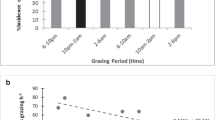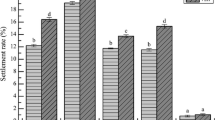Abstract
Benthic diatoms constitute the primary diet of abalone during their early stages of development. To evaluate the dietary preferences of early post-larval abalone, Haliotis diversicolor supertexta, we analyzed the gut contents of post-larvae that settled on diatom films. We compared the abundance and species diversity of diatom assemblages in the gut to those of the epiphytic diatom assemblages on the attachment films, and identified 40 benthic diatom species in the gut contents of post-larvae 12 to 24 d after settlement. The most abundant taxa in the gut contents were Navicula spp., Amphora copulate, and Amphora coffeaeformis. Navicula spp. accounted for 64.0% of the cell density. In the attachment films, we identified 110 diatom species belonging to 38 genera. Pennate diatoms were the dominant members including the species Amphiprora alata, Cocconeis placentula var. euglypta, Cylindrotheca closterium, Navicula sp. 2, and A. coffeaeformis. Nano-diatoms (<20 μm in length) accounted for a considerable proportion of the total species number and cell density of the diatom assemblages in the gut contents and on the films. This suggests that nano-diatoms are important to the efficient production of abalone seed. The difference of the composition and abundance of diatoms between in the guts and on the biofilms suggests that early post-larval grazing was selective. An early post-larval abalone preferred nano-diatoms and the genera Navicula and Amphora during the month after settlement.
Similar content being viewed by others
References
Daume S, Brand-Gardner S, Woelkerling W J. 1999. Preferential settlement of abalone larvae: diatom films vs. non-geniculate coralline algae. Aquaculture, 174: 243–254.
Daume S, Krsinich A, Farrell S, Gervis M. 2000. Settlement, early growth and survival of Haliotis rubra in response to different algal species. J. Appl. Phycol., 12: 479–488.
Dusan L, Ken S, James G M, Ratnesh L, Nicolas H V. 2007. AFM Nanoindentations of Diatom Biosilica Surfaces. Langmuir, 5 014–5 021.
Dustan G A, Volkman J K, Barrett S M, Leroi J M, Jeffrey S W. 1994. Essential polyunsaturated fatty acids from 14 species of diatom (Bacillariophyceae). Phytochemistry, 35: 155–161.
Ebert E, Houk J. 1984. Elements and innovations in the cultivation of red abalone Haliotis rufescens. Aquaculture, 39: 375–392.
Gallardo W G, Buen S M A. 2003. Evaluation of mucus, Navicula, and mixed diatoms as larval settlement inducers for the tropical abalone Haliotis asinina. Aquaculture, 221: 357–364.
Gordon N, Neori A, Shpigel M, Lee J, Harpaz S. 2006. Effect of diatom diets on growth and survival of the abalone Haliotis discus hannai post-larval. Aquaculture, 252: 225–233.
Gordon N, Shpigel M, Harpaz S, Lee J J, Neori A. 2004. The settlement of abalone (Haliotis discus hannai Ino) larvae on culture layers of different diatoms. J. Shellfish Res., 23: 561–568.
Jin D X, Chen J H, Huang K G. 1965. Marine Phytoplank Diatoms of China. Shanghai Scientific & Technical Publishers, Shanghai, China. 230p. (in Chinese)
Jin D X, Cheng Z D, Lin J M, Liu S C. 1982. The Marine Benthic Diatoms in China, Vol. 1. Ocean Press, Beijing, China. 323p. (in Chinese)
Jin D X, Cheng Z D, Liu S C, Ma J H. 1992. The Marine Benthic Diatoms in China vol. 2. Ocean Press, Beijing, China. 437p. (in Chinese)
Kawamura T. 1996. The role of benthic diatoms in the early life stages of the Japanese abalone Haliotis discus hannai. In: Watanabe Y, Yamashita Y, Oozeki Y eds. Survival strategies in early life stages of marine resources. Balkema, Rotterdam. p. 355–367.
Kawamura T, Roberts D R, Nicholson M C. 1998a. Factors affecting the food value of diatom strains for post-larval abalone Haliotis iris. Aquaculture, 160: 81–88.
Kawamura T, Roberts D R, Takami H. 1998b. A review of the feeding and growth of post-larval abalone. J. Shellfish Res., 17: 615–625.
Kawamura T, Saido T, Takami H, Yamashita Y. 1995a. Dietary value of benthic diatoms for the growth of post-larval Haliotis discus hannai. J. Exp. Mar. Biol. Ecol., 194: 189–199.
Kawamura T, Takami H. 1995b. Analysis of feeding and growth rate of newly metamorphosed abalone Haliotis discus hannai fed on four species of benthic diatom. Fish. Sci., 61: 357–358.
Martínez-Ponce D R, Searcy-Bernal R. 1998. Grazing rates of red abalone (Haliotis rufescens) postlarvae feeding on the benthic diatom Navicula incerta. J. Shellfish Res., 17: 627–630.
Nie Z Q, Wang S P. 2004. The status of abalone culture in China. J. Shellfish Res., 23: 941–945.
Norman-Boudreau K, Burns D, Cooke C A, Austin A. 1986. A simple technique for detection of feeding in newly metamorphosed abalone. Aquaculture, 51: 313–317.
Roberts R D, Kawamura T, Nicholson C M. 1999. Growth and survival of post-larval abalone (Haliotis iris) in relation to development and diatom diet. J. Shellfish Res., 18: 243–250.
Seki T, Kan-no H. 1981. Observations on the settlement and metamorphosis of the veliger of the Japanese abalone Haliotis discus hannai Ino, Haliotidae, Gastropoda. Bull. Tohoku Reg. Fish. Res. Lab., 42: 31–39.
Siqueiros-Beltrones David A, Domenico Voltolina. 2000. Grazing selectivity of red abalone Haliotis rufescens postlarvae on benthic diatom films under culture conditions. J. World Aquacult. Soc., 32: 239–246.
Xing R L, Wang C H, Cao X B. 2008. Settlement, growth and survival of abalone, Haliotis discus hannai, in response to eight monospecific benthic diatoms. J. Appl. Phycol., 20: 47–53.
Zhang G F, Que H Y, Liu X, Xu H S. 2004. Abalone mariculture in China. J. Shellfish Res., 23: 947–950.
Author information
Authors and Affiliations
Corresponding author
Additional information
Supported by Special Project on Basic Research of China, Ministry of Science and Technology (No. 2006FY120100) and Natural Science Foundation of Fujian Province (No. B0510005; 2005YZ1024)
Rights and permissions
About this article
Cite this article
Zhang, Y., Gao, Y., Liang, J. et al. Diatom diet selectivity by early post-larval abalone Haliotis diversicolor supertexta under hatchery conditions. Chin. J. Ocean. Limnol. 28, 1187–1194 (2010). https://doi.org/10.1007/s00343-010-0019-x
Received:
Accepted:
Published:
Issue Date:
DOI: https://doi.org/10.1007/s00343-010-0019-x




